Marcella Cornia
Recurrence Meets Transformers for Universal Multimodal Retrieval
Sep 10, 2025Abstract:With the rapid advancement of multimodal retrieval and its application in LLMs and multimodal LLMs, increasingly complex retrieval tasks have emerged. Existing methods predominantly rely on task-specific fine-tuning of vision-language models and are limited to single-modality queries or documents. In this paper, we propose ReT-2, a unified retrieval model that supports multimodal queries, composed of both images and text, and searches across multimodal document collections where text and images coexist. ReT-2 leverages multi-layer representations and a recurrent Transformer architecture with LSTM-inspired gating mechanisms to dynamically integrate information across layers and modalities, capturing fine-grained visual and textual details. We evaluate ReT-2 on the challenging M2KR and M-BEIR benchmarks across different retrieval configurations. Results demonstrate that ReT-2 consistently achieves state-of-the-art performance across diverse settings, while offering faster inference and reduced memory usage compared to prior approaches. When integrated into retrieval-augmented generation pipelines, ReT-2 also improves downstream performance on Encyclopedic-VQA and InfoSeek datasets. Our source code and trained models are publicly available at: https://github.com/aimagelab/ReT-2
RAID: A Dataset for Testing the Adversarial Robustness of AI-Generated Image Detectors
Jun 09, 2025Abstract:AI-generated images have reached a quality level at which humans are incapable of reliably distinguishing them from real images. To counteract the inherent risk of fraud and disinformation, the detection of AI-generated images is a pressing challenge and an active research topic. While many of the presented methods claim to achieve high detection accuracy, they are usually evaluated under idealized conditions. In particular, the adversarial robustness is often neglected, potentially due to a lack of awareness or the substantial effort required to conduct a comprehensive robustness analysis. In this work, we tackle this problem by providing a simpler means to assess the robustness of AI-generated image detectors. We present RAID (Robust evaluation of AI-generated image Detectors), a dataset of 72k diverse and highly transferable adversarial examples. The dataset is created by running attacks against an ensemble of seven state-of-the-art detectors and images generated by four different text-to-image models. Extensive experiments show that our methodology generates adversarial images that transfer with a high success rate to unseen detectors, which can be used to quickly provide an approximate yet still reliable estimate of a detector's adversarial robustness. Our findings indicate that current state-of-the-art AI-generated image detectors can be easily deceived by adversarial examples, highlighting the critical need for the development of more robust methods. We release our dataset at https://huggingface.co/datasets/aimagelab/RAID and evaluation code at https://github.com/pralab/RAID.
Inverse Virtual Try-On: Generating Multi-Category Product-Style Images from Clothed Individuals
May 27, 2025Abstract:While virtual try-on (VTON) systems aim to render a garment onto a target person image, this paper tackles the novel task of virtual try-off (VTOFF), which addresses the inverse problem: generating standardized product images of garments from real-world photos of clothed individuals. Unlike VTON, which must resolve diverse pose and style variations, VTOFF benefits from a consistent and well-defined output format -- typically a flat, lay-down-style representation of the garment -- making it a promising tool for data generation and dataset enhancement. However, existing VTOFF approaches face two major limitations: (i) difficulty in disentangling garment features from occlusions and complex poses, often leading to visual artifacts, and (ii) restricted applicability to single-category garments (e.g., upper-body clothes only), limiting generalization. To address these challenges, we present Text-Enhanced MUlti-category Virtual Try-Off (TEMU-VTOFF), a novel architecture featuring a dual DiT-based backbone with a modified multimodal attention mechanism for robust garment feature extraction. Our architecture is designed to receive garment information from multiple modalities like images, text, and masks to work in a multi-category setting. Finally, we propose an additional alignment module to further refine the generated visual details. Experiments on VITON-HD and Dress Code datasets show that TEMU-VTOFF sets a new state-of-the-art on the VTOFF task, significantly improving both visual quality and fidelity to the target garments.
What Changed? Detecting and Evaluating Instruction-Guided Image Edits with Multimodal Large Language Models
May 26, 2025Abstract:Instruction-based image editing models offer increased personalization opportunities in generative tasks. However, properly evaluating their results is challenging, and most of the existing metrics lag in terms of alignment with human judgment and explainability. To tackle these issues, we introduce DICE (DIfference Coherence Estimator), a model designed to detect localized differences between the original and the edited image and to assess their relevance to the given modification request. DICE consists of two key components: a difference detector and a coherence estimator, both built on an autoregressive Multimodal Large Language Model (MLLM) and trained using a strategy that leverages self-supervision, distillation from inpainting networks, and full supervision. Through extensive experiments, we evaluate each stage of our pipeline, comparing different MLLMs within the proposed framework. We demonstrate that DICE effectively identifies coherent edits, effectively evaluating images generated by different editing models with a strong correlation with human judgment. We publicly release our source code, models, and data.
Improving LLM First-Token Predictions in Multiple-Choice Question Answering via Prefilling Attack
May 21, 2025Abstract:Large Language Models (LLMs) are increasingly evaluated on multiple-choice question answering (MCQA) tasks using *first-token probability* (FTP), which selects the answer option whose initial token has the highest likelihood. While efficient, FTP can be fragile: models may assign high probability to unrelated tokens (*misalignment*) or use a valid token merely as part of a generic preamble rather than as a clear answer choice (*misinterpretation*), undermining the reliability of symbolic evaluation. We propose a simple solution: the *prefilling attack*, a structured natural-language prefix (e.g., "*The correct option is:*") prepended to the model output. Originally explored in AI safety, we repurpose prefilling to steer the model to respond with a clean, valid option, without modifying its parameters. Empirically, the FTP with prefilling strategy substantially improves accuracy, calibration, and output consistency across a broad set of LLMs and MCQA benchmarks. It outperforms standard FTP and often matches the performance of open-ended generation approaches that require full decoding and external classifiers, while being significantly more efficient. Our findings suggest that prefilling is a simple, robust, and low-cost method to enhance the reliability of FTP-based evaluation in multiple-choice settings.
Fashion-RAG: Multimodal Fashion Image Editing via Retrieval-Augmented Generation
Apr 18, 2025Abstract:In recent years, the fashion industry has increasingly adopted AI technologies to enhance customer experience, driven by the proliferation of e-commerce platforms and virtual applications. Among the various tasks, virtual try-on and multimodal fashion image editing -- which utilizes diverse input modalities such as text, garment sketches, and body poses -- have become a key area of research. Diffusion models have emerged as a leading approach for such generative tasks, offering superior image quality and diversity. However, most existing virtual try-on methods rely on having a specific garment input, which is often impractical in real-world scenarios where users may only provide textual specifications. To address this limitation, in this work we introduce Fashion Retrieval-Augmented Generation (Fashion-RAG), a novel method that enables the customization of fashion items based on user preferences provided in textual form. Our approach retrieves multiple garments that match the input specifications and generates a personalized image by incorporating attributes from the retrieved items. To achieve this, we employ textual inversion techniques, where retrieved garment images are projected into the textual embedding space of the Stable Diffusion text encoder, allowing seamless integration of retrieved elements into the generative process. Experimental results on the Dress Code dataset demonstrate that Fashion-RAG outperforms existing methods both qualitatively and quantitatively, effectively capturing fine-grained visual details from retrieved garments. To the best of our knowledge, this is the first work to introduce a retrieval-augmented generation approach specifically tailored for multimodal fashion image editing.
LLaVA-MORE: A Comparative Study of LLMs and Visual Backbones for Enhanced Visual Instruction Tuning
Mar 19, 2025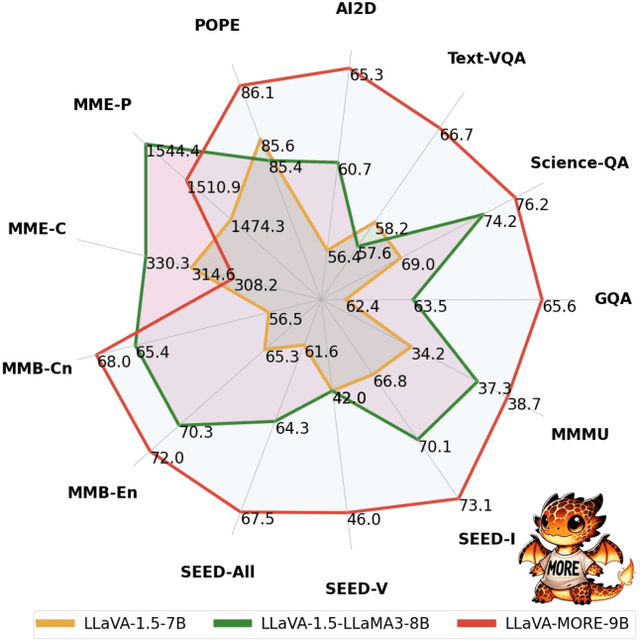
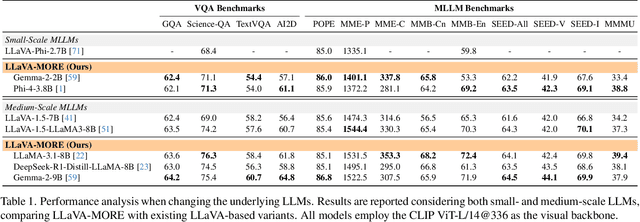
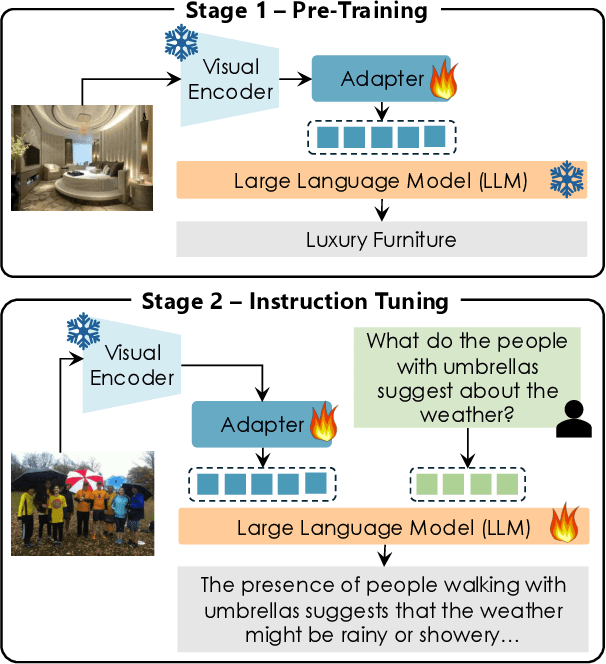

Abstract:Recent progress in Multimodal Large Language Models (MLLMs) has highlighted the critical roles of both the visual backbone and the underlying language model. While prior work has primarily focused on scaling these components to billions of parameters, the trade-offs between model size, architecture, and performance remain underexplored. Additionally, inconsistencies in training data and evaluation protocols have hindered direct comparisons, making it difficult to derive optimal design choices. In this paper, we introduce LLaVA-MORE, a new family of MLLMs that integrates recent language models with diverse visual backbones. To ensure fair comparisons, we employ a unified training protocol applied consistently across all architectures. Our analysis systematically explores both small- and medium-scale LLMs -- including Phi-4, LLaMA-3.1, and Gemma-2 -- to evaluate multimodal reasoning, generation, and instruction following, while examining the relationship between model size and performance. Beyond evaluating the LLM impact on final results, we conduct a comprehensive study of various visual encoders, ranging from CLIP-based architectures to alternatives such as DINOv2, SigLIP, and SigLIP2. Additional experiments investigate the effects of increased image resolution and variations in pre-training datasets. Overall, our results provide insights into the design of more effective MLLMs, offering a reproducible evaluation framework that facilitates direct comparisons and can guide future model development. Our source code and trained models are publicly available at: https://github.com/aimagelab/LLaVA-MORE.
Image Captioning Evaluation in the Age of Multimodal LLMs: Challenges and Future Perspectives
Mar 18, 2025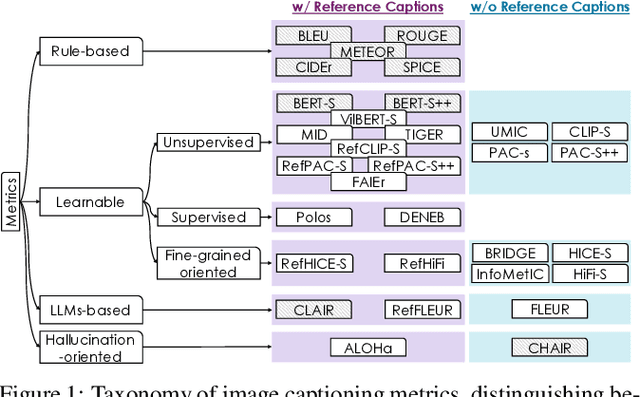
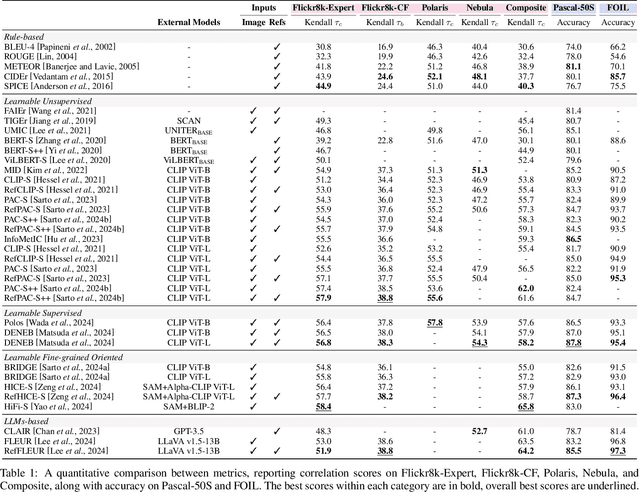
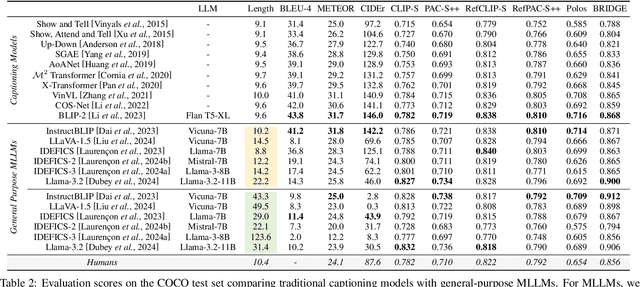

Abstract:The evaluation of machine-generated image captions is a complex and evolving challenge. With the advent of Multimodal Large Language Models (MLLMs), image captioning has become a core task, increasing the need for robust and reliable evaluation metrics. This survey provides a comprehensive overview of advancements in image captioning evaluation, analyzing the evolution, strengths, and limitations of existing metrics. We assess these metrics across multiple dimensions, including correlation with human judgment, ranking accuracy, and sensitivity to hallucinations. Additionally, we explore the challenges posed by the longer and more detailed captions generated by MLLMs and examine the adaptability of current metrics to these stylistic variations. Our analysis highlights some limitations of standard evaluation approaches and suggests promising directions for future research in image captioning assessment.
Recurrence-Enhanced Vision-and-Language Transformers for Robust Multimodal Document Retrieval
Mar 03, 2025Abstract:Cross-modal retrieval is gaining increasing efficacy and interest from the research community, thanks to large-scale training, novel architectural and learning designs, and its application in LLMs and multimodal LLMs. In this paper, we move a step forward and design an approach that allows for multimodal queries, composed of both an image and a text, and can search within collections of multimodal documents, where images and text are interleaved. Our model, ReT, employs multi-level representations extracted from different layers of both visual and textual backbones, both at the query and document side. To allow for multi-level and cross-modal understanding and feature extraction, ReT employs a novel Transformer-based recurrent cell that integrates both textual and visual features at different layers, and leverages sigmoidal gates inspired by the classical design of LSTMs. Extensive experiments on M2KR and M-BEIR benchmarks show that ReT achieves state-of-the-art performance across diverse settings. Our source code and trained models are publicly available at https://github.com/aimagelab/ReT.
Personalizing Multimodal Large Language Models for Image Captioning: An Experimental Analysis
Dec 04, 2024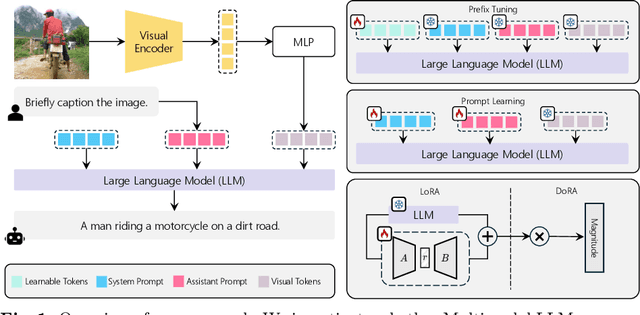
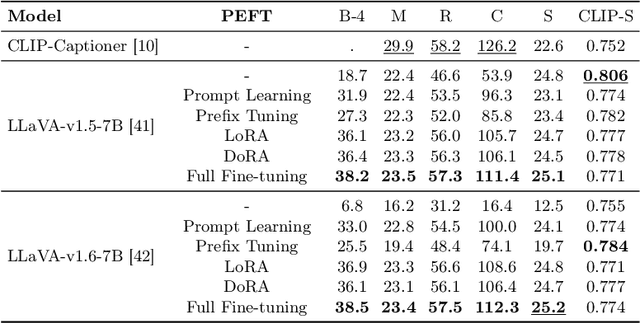

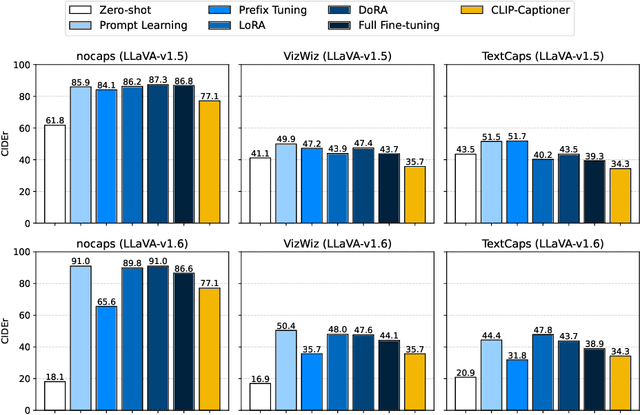
Abstract:The task of image captioning demands an algorithm to generate natural language descriptions of visual inputs. Recent advancements have seen a convergence between image captioning research and the development of Large Language Models (LLMs) and Multimodal LLMs -- like GPT-4V and Gemini -- which extend the capabilities of text-only LLMs to multiple modalities. This paper investigates whether Multimodal LLMs can supplant traditional image captioning networks by evaluating their performance on various image description benchmarks. We explore both the zero-shot capabilities of these models and their adaptability to different semantic domains through fine-tuning methods, including prompt learning, prefix tuning, and low-rank adaptation. Our results demonstrate that while Multimodal LLMs achieve impressive zero-shot performance, fine-tuning for specific domains while maintaining their generalization capabilities intact remains challenging. We discuss the implications of these findings for future research in image captioning and the development of more adaptable Multimodal LLMs.
 Add to Chrome
Add to Chrome Add to Firefox
Add to Firefox Add to Edge
Add to Edge